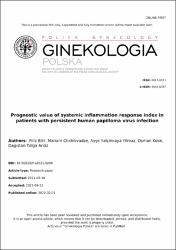Prognostic value of systemic inflammation response index in patients with persistent human papilloma virus infection
Künye
Bilir, F., Chkhikvadze, M., Yilmaz, A. Y., Kose, O., & Arıöz, D. T. (2022). Prognostic value of systemic inflammation response index in patients with persistent human papilloma virus infection. Ginekologia Polska.Özet
Objectives: Persistent human papilloma virus (HPV) infection is a risk factor for the progression of cervical neoplasia into invasive carcinoma. Many inflammatory markers obtaining from hemogram parameters as platelets, monocytes, lymphocytes, and neutrophils or their ratios are still under investigation in recent decades, especially in the oncology era. Indeed, there have not been enough data about the relationship between these parameters and cervical cancer in the literature. Our primary aim was to investigate the possible relationship between the persistent HPV, which is one of the significant risk factors of cervical cancer, and these inflammatory markers. Further, we can add an easy follow-up parameter in women with persistent HPV infection. Material and methods: The study included patients between 30–65 years old, tested positive for HPV, and afterward had an HPV control test between January 2015 and June 2020. Results: The study included 114 HPV DNA-positive patients. The mean age was 43 (standard deviation 8.7), and 41 of them (36%) had persistent HPV, but the remaining 73 (64%) did not. The baseline neutrophil/lymphocyte ratio (NLR) value was 2.1, platelet/lymphocyte ratio (PLR) was 133, monocyte/lymphocyte ratio (MLR) was 0.28, and systemic inflammation response index (SIRI) was 0.9. All the parameters were significantly higher in the persistent HPV group compared to the non-persistent group. Patients who had 0.65 and under this had a significantly lower risk of persistent HPV. Conclusions: Persistent HPV disease can be predicted with an elevated SIRI, NLR, and other hematologic parameters. So, we can closely follow up with these patients with different algorithms to prevent cervical cancer.
















